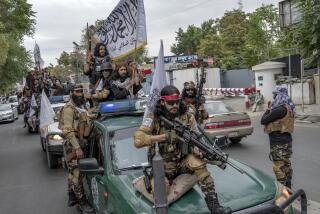U.S., Afghan forces launch assault in southern Afghanistan
Reporting from Howz-e-Madad, Afghanistan â Hundreds of U.S. and Afghan troops pushed into insurgent-dominated areas west of Kandahar city early Wednesday, hoping to establish a foothold not far from the area where the Taliban movement was born.
The assault south of the main highway in the Zhari district by elements of the 101st Airborne Division was aimed at cutting off routes that insurgents use to move fighters, explosives and drugs into Kandahar, Afghanistanâs second-largest city.
The operation, which involves parts of three U.S. battalions, as well as British engineers deployed to help clear hidden bombs, is one of the biggest troop actions in a months-long military campaign in the region. Stabilizing the area is one of the main objectives this year, U.S. commanders say.
Since its acceleration this summer, the Kandahar plan has run into repeated delays as insurgents have fought back â fiercely in some areas outside the city â and a U.S.-Afghan government effort to bring power, jobs and other services has proceeded more slowly than promised.
Western Zhari, an area roughly the size of Little Rock, Ark., is likely to see those difficulties deepen because loyalty to the Taliban runs deep.
The Taliban in the area âhas a lot of foot soldiers, and I think these guys intend to fight,â said Lt. Col. Peter N. Benchoff, the 101st battalion commander leading the operation.
Last month, Benchoff summed up the situation in western Zhari in even blunter terms: âSecurity sucks. Development? Nothing substantial. Information campaign? Nobody believes us. Governance? Weâve had one hourlong visit by a government official in the last 2 1/2 months.â
Describing western Zhari as an âenemy-controlled area,â Benchoff said it may take the next year and maybe longer to create enduring security and a permanent Afghan government presence.
His frank assessment underscores the difficulty that the U.S. faces in achieving stability in southern Afghanistan within the timeframe stipulated by President Obama, who has set a deadline of next July to begin removing troops from Afghanistan and handing off responsibility for security to the Afghan army and police.
It also underscores how the U.S. is learning not to overestimate what can be accomplished in southern Afghanistan, as it did in Marja, the town in neighboring Helmand province that Marines stormed in February amid overly optimistic promises that security and services could be delivered quickly.
Army Gen. David H. Petraeus, the U.S. commander in Afghanistan, has said the troop drawdown would be based on conditions on the ground. His point was underscored by Benchoff, who said U.S. forces would probably be in Zhari for at least the next 18 months.
Western Zhari has no permanent Afghan government presence, no open schools and no medical clinics, except for a primitive pharmacy in the local bazaar. The Afghan army battalion that is working with Benchoffâs soldiers arrived only last month, and it is a long way from being able to handle security on its own.
âTheyâve got brand-new soldiers and brand-new junior officers,â Benchoff said of the Afghan unit. âRight now, they are deferring more to us.â
The U.S. base hugging the highway is regularly hit by mortar rounds and rocket-propelled grenades. Three contractors working on the base were killed last week in a mortar attack, and a fourth suffered minor wounds when a round struck the tent where he was working.
Two miles south of the U.S. base is the village of Sangsar, the place where, in early 1994, Mullah Mohammed Omar, then an obscure local cleric, reportedly ordered a warlord who had raped two teenagers to be hanged from the barrel of a tank in the village square.
The Taliban movement that arose from that event eventually took control of Afghanistan in the mid-1990s and gave sanctuary to Osama bin Laden before the Sept. 11, 2001, terrorist attacks in the United States. Today, the one-eyed Omar is believed to be hiding in nearby Pakistan â as is Bin Laden â and still presiding over the council of Taliban leaders who direct the insurgency in Afghanistan.
His home base, a swath of grape arbors, melon fields and small villages, has remained stubbornly aligned with the Taliban despite repeated coalition military operations over the years aimed at clearing out the insurgents. A Canadian-led force pushed into Zhari and the adjoining district of Panjwayi in 2006, but 28 personnel were killed and the force soon withdrew, allowing the Taliban to infiltrate back.
Benchoff said that, in the ongoing operation, U.S. and Afghan troops will gradually expand their presence in Taliban strongholds in coming months as they begin to understand the area better.
âWe could come in here right now and make a bunch of assumptions and end up being wrong about the enemy,â Benchoff said. âIt takes a little while to figure out his game plan.â
More to Read
Sign up for Essential California
The most important California stories and recommendations in your inbox every morning.
You may occasionally receive promotional content from the Los Angeles Times.











